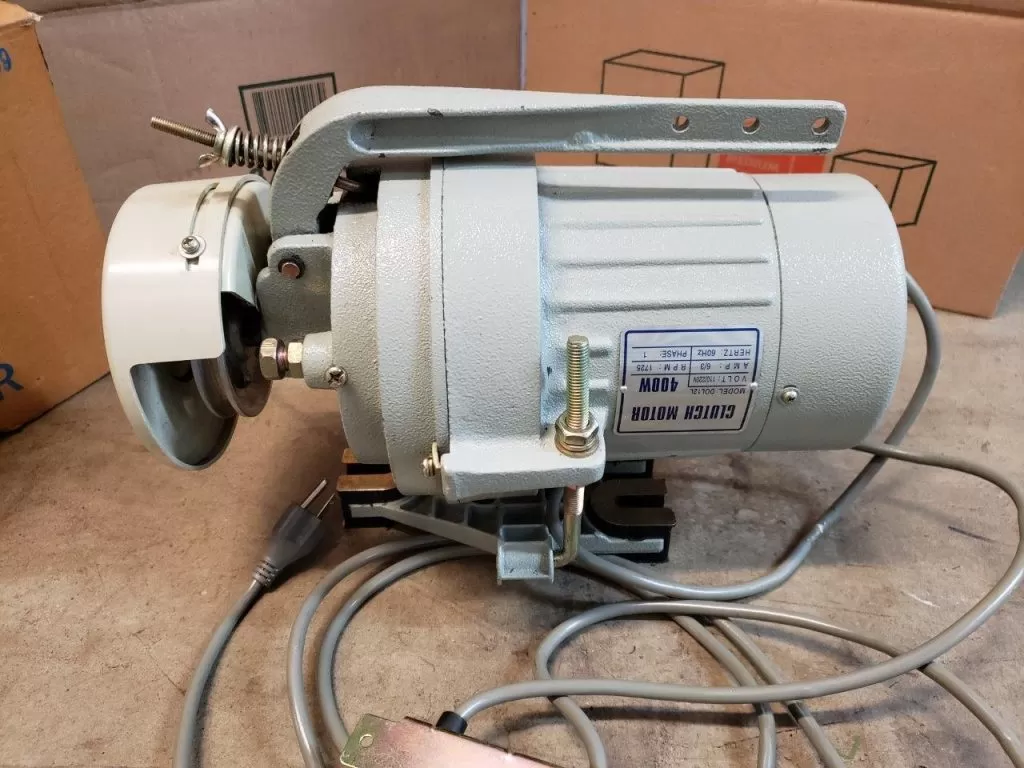Option C: Clutch Motor
Option C : Clutch Motor
See the parent article: Choosing a Motor
Online mostly you will see clutch motors disparaged as a thing of the past, going too fast, with little control. Yet there are ways to tame them by slowing them down (gear reduction and/or VFD) and getting better at feathering the clutch.

1. What is a clutch
Just like in an old school automobile with a manual transmission and a clutch, a clutch in a sewing machine motor allows the motor and the sewing machine to move at different speeds. The pedal motion is opposite that of an automobile though— on a sewing machine you press harder to achieve full engagement, and let off to stop.
1a. What is the clutch made of
The clutch typically has a cork surface pressing against a steel pressure plate.
1b. Why do they go so fast
Not all clutch motors go the same speed. A clutch motor is typically run by an AC induction motor. The no-load speed of the motor is determined by the input frequency (typically 50Hz or 60Hz) and the number of electromagnetic poles (how the motor is wound).
The clutch motors I’ve seen are either 2-pole (about 2800rpm @ 60Hz) or 4-pole (about 1400rpm @ 60Hz). Notice one is twice as fast as the other. You want the slower one.
1c. How to reduce the maximum speed
Here are some ways you can reduce the maximum speed of the machine when using a clutch motor:
- Get a 4-pole motor instead of a 2-pole motor.
- Buy a 45mm motor pulley (the pulley that goes on the end of the motor) for about ten dollars.
- Add a gear reducer (about $110 for 3:1 belt gear reducer).
- Get a 3-phase clutch motor, then reduce the motor’s input frequency using a VFD, which will reduce the motor speed proportionally.
1d. How to Make it Easier to Drive
- First slow it down so that its maximum speed is actually of use to you. That is, so that on your long straightaway runs you can comfortably be full on the gas. See previous section.
- Reduce the amount of belt tension at the clutch motor pulley to be just enough to go through your thickest material—this helps prevent machine breakage if anything like your hook gets bound up. It also means there will be less force (and therefore less friction) on the main sliding part of the clutch actuator. You want as little friction as possible on the main slider, because friction here means the clutch won’t back off when you back off, and it will be harder to control.
- Take the clutch off the end of the motor. Clean all the pivot points and the main slide sleeve. Clean them up with sandpaper and/or a file if they have rough spots. Grease all the pivot points (and especially the main slide sleeve), and put it back together. (Oil is not as good as grease when it comes to low friction at very low sliding speeds)
- Once your clutch is back on the motor, pull down on the actuating arm. Then release some pressure on the actuating arm. It should back off a little every time you back off a little. If not, see previous steps.
- Set the machine for a short stitch length, and make some practice runs (with or without thread).
- Experiment with how much leverage the treadle has against the actuating lever, and find what works best for you.
- Experiment with varying levels of spring tension on the actuating lever.
- (Optional) Add a heavier flywheel to the motor pulley. (My Singer clutch motor has two flywheels: A seven pound flywheel connected to the motor that is spinning constantly, and a half pound flywheel right next to the motor pulley. It’s the one next to the motor pulley that you want to increase—like adding a low pass filter to the system.)
- (Optional) Wiz recommends greasing the clutch surface, but I have not tried that yet so I don’t have any data.
2. Is a Clutch Motor the Right Motor for Me?
Choose a clutch motor if:
- You already have a 4-pole (1400rpm) clutch motor and are willing to gear it down to an appropriate maximum speed
- You can acquire a 3-phase, 4-pole clutch motor (allows using VFD to slow it down)
- You like driving a manual automobile transmission
- You appreciate the extra challenge
- You do most of your sewing at a single speed. That is, with few fluctuations in speed.
- If you are willing to use the hand wheel to provide the precision that you need at the end of each seam. (A well-adjusted clutch motor can get you close…but you’re on your own with the hand wheel to square it up at the end)
- You are good at adjusting things
- You are willing to disassemble and grease the main slider
- You don’t want or need a needle position sensor
- You like the droning sound it makes (just like an old school table saw or belt sander)
Edited by friquant
Added information about greasing the main slide and pivot points



0 Comments
Recommended Comments
There are no comments to display.
Join the conversation
You are posting as a guest. If you have an account, sign in now to post with your account.
Note: Your post will require moderator approval before it will be visible.